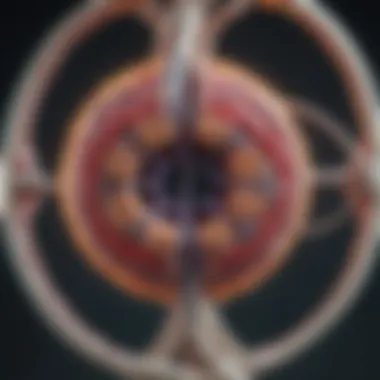Understanding Complex Cystic Structures in Medicine


Intro
The exploration of complex cystic structures is essential in understanding various medical conditions. These formations, often seen in imaging and pathology, require a detailed examination. Accurate analysis and classification of these cysts can lead to improved diagnostic accuracy and enhanced patient management. The article comprehensively reviews the significant findings, methodologies employed in research, and the clinical implications associated with these structures.
Key Findings
Major Results
Complex cystic structures present a wide range of appearances and characteristics depending on their origin and pathology. They can manifest in organs such as the kidneys, liver, and ovaries, often complicating diagnosis and treatment. Key findings from current literature indicate that certain imaging modalities, like ultrasound and MRI, are particularly effective in differentiating between benign and malignant cystic lesions.
However, the classification of these cysts is not universally agreed upon. Various systems, including the Bosniak classification for renal cysts, provide a framework but can still lead to interpretative challenges. Despite these challenges, recent advancements in imaging technology and diagnostic protocols have remarkably improved our ability to assess these structures accurately.
Discussion of Findings
The implications of accurately diagnosing complex cystic structures go beyond mere identification. Misdiagnosis can lead to inappropriate management strategies, impacting patient outcomes. Understanding these cysts' underlying etiologies shed light on their potential risks. For instance, simple renal cysts typically require minimal intervention, while complex cysts may warrant closer surveillance, biopsies, or surgical approaches.
"The accurate identification and classification of complex cystic structures remain a cornerstone of effective clinical management, potentially altering the course of patient care."
Methodology
Research Design
The research design adopted in the examination of complex cystic structures involves a thorough literature review and analysis of clinical case studies. By synthesizing data from various peer-reviewed articles, the research aims to provide a holistic perspective on the subject matter. Furthermore, clinical trials may augment this research design by highlighting patient experiences and outcomes related to different management techniques.
Data Collection Methods
Data collection methods utilized in the research encompass:
- Review of imaging studies (CT, MRI, Ultrasound)
- Analysis of histopathological reports
- Case studies from clinical practices
- Surveys from healthcare professionals regarding diagnostic approaches and management strategies
These methods allow for a comprehensive assessment of the existing knowledge on complex cystic structures, facilitating a deeper understanding of their implications for clinical practice and ongoing research.
The significance and relevancy of findings in this domain augment our clinical decision-making and inform strategies for future research.
Understanding Complex Cystic Structures
Understanding complex cystic structures is vital in the context of medical imaging and diagnosis. These structures, which can appear in various organs, present challenges that require keen observation and analysis. Their significance lies not only in their appearance but also in their potential implications for patient outcomes. Definition clarity, characteristics, and classifications associated with complex cystic structures play a crucial role in medical assessments.
Definition of Cystic Structures
Cystic structures refer to fluid-filled sacs that can develop in various tissues, often identified via imaging techniques. They can be categorized as simple or complex based on their internal architecture and other criteria. Simple cysts are typically unilocular and contain clear fluid, whereas complex cysts may exhibit multilocularity, solid components, or internal septations.
This differentiation is essential for accurately diagnosing potential underlying conditions, which can range from benign to malignant processes.
Differences Between Simple and Complex Cysts
The distinctions between simple and complex cysts are critical. Simple cysts usually appear homogeneous on imaging and do not exhibit significant internal features. They are often incidental findings and are generally not associated with severe complications or diseases.
In contrast, complex cysts contain more intricate features. They may have:
- Thicker walls
- Solid components within the fluid
- Septations dividing the cyst into compartments
- Variability in echogenicity on ultrasound
Recognizing these differences can lead to more accurate diagnoses and, ultimately, better patient management.
Importance in Medical Imaging
The role of medical imaging in evaluating cystic structures cannot be overstated. Various techniques are used, including:
- Ultrasound: Often the first step in evaluation, it provides a preliminary assessment of cystic structures based on their appearance and characteristics.
- CT Scans: Computed tomography provides cross-sectional images, aiding in further distinction between simple and complex cysts and offering detailed visualization of the internal structure.
- MRI: Magnetic resonance imaging offers exceptional soft tissue contrast, which is essential for assessing complex cystic structures more accurately.
Imaging not only helps in identifying the nature of the cyst but also plays a crucial part in planning treatment, when necessary. The accurate evaluation of these cystic formations can significantly influence clinical decisions, ensuring tailored management strategies are implemented.
Types of Complex Cystic Lesions
Understanding complex cystic lesions is pivotal in the field of medicine. It helps in distinguishing between various types of lesions, which directly influences diagnosis and treatment approaches. The identification and classification of these lesions can lead to significant benefits in terms of patient care. Correct interpretation of lesions can guide the physician in making informed decisions, ensuring timely intervention when required.


Classification Criteria
The classification of complex cystic lesions is essential for developing an effective diagnostic strategy. Various criteria exist to determine the nature and significance of these cysts. Radiologists often rely on imaging characteristics such as:
- Morphology: The shape and contour of the lesion can provide initial clues to its classification.
- Content: The internal contents, whether liquid or solid, along with any septations noticed.
- Wall Characteristics: The thickness and nature of the cyst wall play a critical role in classification.
Each criterion holds specific relevance to how a lesion may be categorized and interpreted clinically. For instance, the presence of solid components within a cyst often raises suspicion for malignancy, warranting further investigation.
Common Examples
Complex cystic lesions can appear in various anatomical sites. The following are common examples:
Complex renal cysts
Complex renal cysts represent a significant category within renal pathology. Their key characteristic lies in the irregular septations and altered echogenicity noted during imaging. These features can indicate the potential for malignancy, making their evaluation crucial for managing renal health. The unique feature of complex renal cysts is their variable appearance on imaging studies.
The advantages of identifying complex renal cysts include early detection of renal tumors. However, a disadvantage may be the likelihood of over-diagnosing malignant conditions, leading to unnecessary anxiety for patients.
Complex ovarian cysts
Complex ovarian cysts often bring substantial attention, especially in gynecology. They frequently present with both liquid and solid components, which is a key characteristic that sets them apart from simple cysts. Their identification is crucial because it can indicate possible ovarian malignancies, especially in postmenopausal women.
A unique feature of complex ovarian cysts is their fluid levels, which can shift based on hormonal cycles. This variability makes them a popular choice for discussion in clinical settings, as it often requires monitoring over time. The disadvantages involve the need for regular imaging and potential surgical interventions for diagnosis, which may pose risks to patients.
Complex pancreatic cysts
Complex pancreatic cysts are also a noteworthy example. Their specific aspect includes the potential to harbor neoplastic processes. Complexity in these cysts often arises from the development of pancreatic pseudocysts related to pancreatitis, along with various neoplastic lesions. Their key characteristic is the presence of thick, irregular walls or internal debris, indicating underlying pathology.
The unique feature of complex pancreatic cysts is their association with serious conditions such as pancreatic carcinoma. This alarming potential makes them a vital focus in imaging studies of the abdomen. While the identification of such cysts allows for beneficial early intervention, it also presents challenges due to the invasive nature of required assessment methods.
"Effective classification and management of complex cystic lesions can significantly affect patient outcomes and guide treatment strategies."
This overview highlights the diversity within complex cystic lesions. Each example offers critical insights into their implications for medical practice and patient welfare.
Etiology and Pathogenesis
Understanding the etiology and pathogenesis of complex cystic structures is crucial. It not only sheds light on their origins but also informs clinical approaches to management and treatment. The genesis of these cystic formations involves a complex interplay of genetic, environmental, and pathological factors. Dissecting these layers allows medical professionals to distinguish between benign and malignant variants, significantly impacting patient outcomes.
Genetic Factors
Genetic factors play an important role in the formation of complex cystic structures. Variations in specific genes can predispose individuals to develop these lesions. For instance, certain inherited conditions such as von Hippel-Lindau disease increase the risk of renal cysts. Moreover, genes associated with cellular growth and differentiation often influence the development of cystic lesions. Understanding the genetic predispositions can aid in early diagnosis and preventive strategies. Genetic testing can be a useful tool for clinicians to identify high-risk patients.
Environmental Influences
Environmental influences encompass a wide range of factors that can either contribute to or inhibit the formation of complex cystic structures. Exposure to specific toxins, chemicals, or pollutants in the environment may have a direct correlation with the development of these cysts. Furthermore, lifestyle choices, such as diet or smoking, can also affect cyst formation. Recognizing these elements becomes essential in providing holistic patient care. Clinicians must consider environmental background when assessing patients, as this can lead to more tailored preventative measures.
Pathological Mechanisms
Pathological mechanisms underlie the transformation of normal tissue into complex cystic structures. These mechanisms often involve processes like chronic inflammation, tissue ischemia, or abnormal cellular proliferation. For instance, the presence of chronic inflammation can lead to fibrosis and the subsequent accumulation of fluid-filled spaces, resulting in cyst formation. Moreover, dysregulation of signaling pathways involved in cell growth can further contribute. Understanding these mechanisms provides valuable insights, not just for diagnosis but also for potential therapeutic interventions.
Effective management of complex cysts necessitates a thorough grasp of their etiology and pathogenesis. This deepened understanding allows for more precise diagnostic and treatment pathways.
Diagnostic Evaluation of Complex Cysts
The diagnostic evaluation of complex cysts stands as a pivotal component in the overall comprehension and management of these formations. It encompasses various methodologies that aim to identify, classify, and determine the significance of these cystic structures in clinical practice. This section focuses on the specific elements and benefits of diagnostic evaluations, highlighting the importance of accurate diagnosis in treatment planning and patient outcomes.
Imaging Techniques
Imaging techniques provide critical insights into the structure and nature of complex cysts. These modalities help in identifying the cyst's characteristics such as size, location, and internal structure, aiding in differential diagnosis and subsequent management. There are three primary imaging techniques utilized in this context: ultrasound, CT scans, and MRI.
Ultrasound
Ultrasound is a widely used imaging method due to its non-invasive nature and accessibility. It plays a significant role in evaluating complex cystic structures, offering real-time imaging without the need for ionizing radiation.
One of the key characteristics of ultrasound is its ability to provide detailed views of cyst walls and contents. It is a beneficial choice for initial evaluations because it can distinguish between solid and fluid-filled lesions.


One unique feature of ultrasound is its Doppler capability, which helps assess blood flow within lesions, providing further information about their vascularity.
The advantages of ultrasound include its safety, cost-effectiveness, and ability to quickly obtain results. However, it has its disadvantages too. The quality of ultrasound images can be affected by body habitus and operator experience, potentially leading to limitations in visualization.
CT scans
CT scans are another cornerstone in the diagnostic evaluation of complex cystic formations. They deliver detailed cross-sectional images of the body, offering enhanced visualization of internal structures compared to ultrasound.
Key characteristics of CT scans include their capacity for high-resolution imaging, which is crucial for assessing complex lesions' morphology and characteristics. This imaging modality is a popular choice when more intricate anatomical details are required.
A unique aspect of CT scans is their ability to capture images in multiple planes and contrast-enhanced studies, which can reveal subtle differences between various lesions. The advantages of CT scans include their rapid acquisition time and ability to identify calcifications or other patterns indicative of malignancy. However, the disadvantages involve exposure to ionizing radiation and potentially higher costs than ultrasound.
MRI
MRI is a powerful imaging technique known for its impressive soft tissue contrast. In the context of complex cysts, it is invaluable for providing comprehensive details about the lesions' composition.
The key characteristic of MRI is its ability to produce detailed images without the use of radiation, relying instead on magnetic fields and radio waves. MRI is a beneficial choice for evaluating the characteristics of complex cysts due to its superior soft tissue contrast.
A unique feature of MRI is the use of different sequences, which can provide various perspectives on fluid characteristics within cysts, helping differentiate between benign and malignant lesions. The advantages of MRI include its detailed imaging capabilities and the absence of radiation. However, it also has disadvantages, such as higher costs and a longer examination time compared to CT scans and ultrasounds.
Biopsy and Histopathological Analysis
Biopsy plays a crucial role in the diagnostic evaluation of complex cysts, particularly when imaging results are inconclusive or when malignancy is suspected. This section will cover the significance of obtaining tissue samples for further analysis, presenting methods and their implications for diagnosis.
Differential Diagnosis
Differential diagnosis is an essential component of the diagnostic evaluation. It involves distinguishing complex cysts from other pathological conditions with similar presentations. This section will discuss common mimickers, the significance of clinical history, and the role of imaging in making accurate distinctions.
Clinical Implications
Understanding clinical implications related to complex cystic structures is essential for optimizing patient outcomes. These implications encompass management strategies, surgical interventions, and long-term follow-up care. They are critical to addressing both the present health issues and potential complications associated with these lesions.
Management Strategies
Effective management of complex cystic structures often begins with a thorough evaluation, including imaging and biopsy when necessary. Management strategies should focus on the type of cyst, its symptoms, and potential complications.
In a clinical setting, practitioners must decide whether the cyst is asymptomatic or if it poses a risk to the patient. Some common management strategies include:
- Observation and regular follow-ups for asymptomatic complex cysts.
- Use of medications to address symptoms, like pain or discomfort.
- Referral for specialized interventions, particularly when cysts exhibit concerning features.
Proper management contributes to better patient outcomes. The goal is to minimize unnecessary procedures while ensuring prompt action against potential malignancies.
Surgical Interventions
Surgical interventions may be required for complex cystic structures exhibiting signs of complications, such as infection or malignancy. The type of surgery often depends on the cyst location and its characteristics. Common surgical options include:
- Laparoscopic cystectomy, which involves the removal of the cyst through small incisions.
- Open surgery for larger or complex cysts that require direct access.
- Drainage procedures to relieve symptoms or infections.
These interventions are essential not just for immediate relief but also to prevent further complications. Proper surgical planning is crucial to reduce risks and ensure a high success rate.
Long-term Monitoring and Follow-up
Long-term monitoring is particularly vital for patients with a history of complex cystic formations. Regular follow-ups allow healthcare providers to observe any changes in the cyst structure. This could involve periodic imaging and clinical evaluations.
Key considerations include:
- Regular ultrasound or MRI to monitor for growth or changes.
- Assessing symptoms to decide if further intervention is needed.
- Continuous patient education regarding warning signs that may necessitate immediate healthcare attention.
Through diligent follow-up practices, healthcare providers can significantly improve outcomes, identifying recurrence early and effectively managing complications.
"The management and follow-up of complex cystic structures should be individualized, ensuring that each patient receives tailored care based on their specific needs."
Ultimately, addressing the clinical implications surrounding complex cystic structures ensures a holistic approach to patient healthcare, emphasizing prevention and proactive management.
Recent Advances in Research


Research into complex cystic structures has evolved significantly, offering fresh insights into their implications in medical science. This section emphasizes the importance of advancements in this area, particularly focusing on diagnostic techniques, emerging therapies, and future directions that could redefine patient management and treatment strategies. Understanding these advances is crucial for students, researchers, educators, and professionals aiming to elevate their knowledge and practices in the field.
Innovations in Diagnostic Techniques
Innovations in diagnostic techniques offer essential tools for assessing complex cystic structures. These advancements enhance both the accuracy and efficiency of diagnosis.
- High-resolution Ultrasound: Improvements in ultrasound technology, such as 3D imaging, allow for better visualization of cystic structures.
- MRI with Enhanced Sequences: Advanced MRI sequences provide detailed insights into cyst characteristics and their surrounding tissues.
- CT Imaging Enhancements: New contrast agents and reconstruction techniques enhance the clarity of CT scans, helping distinguish between types of cysts.
These innovations not only assist in differentiating simple cysts from complex ones but also play a role in identifying potentially malignant changes. As diagnostic precision increases, the risk of misdiagnosis decreases, leading to more appropriate management strategies.
Emerging Therapy Options
Emerging therapy options demonstrate a shift toward more personalized treatment plans. As research progresses, several novel approaches are being developed to address complex cystic structures effectively.
- Targeted Biologics: These therapies focus on specific cystic lesion pathways, leading to fewer side effects and a more effective response.
- Minimally Invasive Techniques: Procedures such as laparoscopic cyst removal are becoming more common, reducing recovery times and associated risks.
- Combination Therapies: The use of multiple treatment modalities may enhance outcomes in patients with complex cysts, particularly those at risk of complications.
These therapy options reflect a growing understanding of individual patient needs, potentially improving overall treatment efficacy and patient satisfaction.
Future Directions in Research
Research into complex cystic structures continues to evolve, presenting several promising future directions. Investigating these areas could yield significant benefits in the understanding and management of cystic conditions.
- Genomic Research: Exploring the genetic basis of cyst formation may lead to targeted interventions in susceptible populations.
- Longitudinal Studies: Assessing the progression of complex cysts over time can provide insights into their natural history and potential outcomes.
- Integrative Approaches: Combining data from imaging, pathology, and patient demographics may lead to improved predictive models for therapy success.
Continuous research in these areas is crucial to advance healthcare practices and enhance patient outcomes, as these complex cystic structures have profound implications across various specialties in medicine.
In summary, recent advances in research related to complex cystic structures are crucial. By enhancing diagnostic capabilities, exploring innovative therapies, and focusing on potential future directions, the medical community can improve understanding and management of these conditions. This knowledge is vital for clinicians aiming to provide optimal care while facilitating ongoing research initiatives.
Case Studies and Clinical Insights
Examining case studies is crucial for understanding complex cystic structures. They provide real-world examples that illustrate diagnostic processes and management strategies. Insights gained from these cases can greatly enhance clinical acumen. Analyzing patient histories, imaging results, and treatment outcomes can reveal patterns that guide future diagnosis and intervention.
Analysis of Patient Cases
Patient cases represent the hallmark of learning in the clinical setting. They offer a rich context for the complexity of cystic lesions. Each case holds unique characteristics that inform practitioners on how to approach similar situations.
For instance, a study involving renal complex cysts highlighted the diverse imaging presentations. The differences between benign and malignant forms were delineated through various imaging techniques such as CT and MRI. Learning from these specifics reinforces the importance of accurate imaging and evaluation.
Moreover, a review of ovarian cyst cases has shown that age, hormonal status, and presenting symptoms significantly influence diagnosis and management.
By analyzing patient cases, clinicians can:
- Identify risk factors related to complex cystic structures.
- Enhance diagnostic accuracy through specific imaging strategies.
- Facilitate improved patient outcomes by adapting management plans based on historical data.
Lessons Learned from Complex Cystic Diagnoses
Lessons gleaned from complex cystic diagnoses extend beyond mere observation. They encompass a range of considerations that have significant clinical implications.
One important insight is that not all complex cysts require surgical intervention. For example, regular follow-up of renal cysts can often suffice. This can prevent unnecessary surgeries and potential complications, highlighting the importance of an individualized approach.
Additionally, case studies illustrate the role of interdisciplinary collaboration in managing complex cysts. Input from radiologists, pathologists, and surgeons can provide a holistic view of the patient's condition, leading to better care decisions.
"A case study can serve as a compass, guiding clinical decisions based on previous insights and outcomes."
In summary, the evaluation of case studies fosters a deeper understanding of the intricacies involved with complex cystic structures. It emphasizes the need for tailored diagnostic and treatment strategies rooted in empirical knowledge.
Culmination
In scrutinizing complex cystic structures, it is critical to underscore their implications in medical practice and research. These formations, which often present unique challenges in diagnosis and treatment, hold profound relevance for healthcare professionals. A thorough understanding enables practitioners to navigate through complexities, making informed decisions regarding patient care.
Summary of Key Points
Several essential aspects emerge from this exploration:
- Definition and Classification: The article begins with a clear definition of cystic structures and distinguishes between simple and complex variants, setting the foundation for further discussion.
- Diagnostic Evaluation: We delve into the significance of various imaging techniques such as ultrasound, CT scans, and MRI, illustrating how each modality contributes to accurate diagnosis.
- Clinical Implications: The management strategies and surgical interventions discussed highlight the necessity of tailored approaches to treatment that consider the unique characteristics of each cystic lesion.
In essence, each section contributes to the holistic understanding of complex cystic structures, outlining both clinical and research perspectives.
Significance for Future Research
Future research into complex cystic structures is pivotal for several reasons. First, advancements in imaging technology and techniques may lead to earlier and more accurate diagnoses, improving patient outcomes. Secondly, continued exploration of etiology and pathogenesis can uncover underlying mechanisms that may inform innovative therapy options.
Moreover, integrating multidisciplinary approaches in research can foster collaboration among various fields, enhancing the depth of knowledge and application in clinical settings. As new findings emerge, they will likely reshape existing paradigms, making ongoing research crucial. With a dedicated focus on these areas, we can contribute to the development of better diagnostic tools and treatment modalities for managing complex cystic structures effectively.



